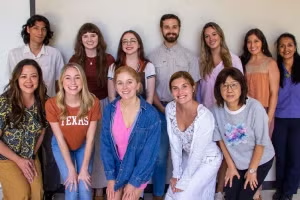
This story is part of our yearlong series “In Pursuit of Health,” covering medical news and research happening across the university.
If heart valves were dial gauges, the aortic valve would be a car speedometer, says Michael Sacks, director of the ICES Center for Cardiovascular Simulation. Its anatomical features are straightforward, self-contained structures that can be replaced when diseased. But the mitral valve which is responsible for receiving oxygenated blood from the lungs into the heart is more akin to an airplane cockpit: complex and interconnected, with changes in one area causing outcomes in others.
The model is our first big effort to incorporate many new features that have not been previously done. This involves really detailed, accurate maps of the structure of the valve.” Michael Sacks
“I’ve been working on valve biomechanics pretty much my entire academic career,” says Sacks, a biomedical engineering professor. “I’m drawn to the mitral valve specifically because it’s the most demanding.”
The complicated nature of the valve is clear when examining the permanence of repairs on regurgitating, or ‘leaky,’ mitral valves, says Sacks. Within five years of surgery, 60 percent of patients with valve problems rooted in ischemic heart disease (characterized by poor blood supply) relapse due to new stresses introduced by repair.
“The problem with these repairs is they have a limited life. Over time, some will do very well and some will not,” says Sacks. “This is where the problems come in.”
Sacks is working to improve long-term repair outcomes by creating a computational replica of the valve that maps the complex network of stresses that influence the valve’s form and function. His vision for the model is as a patient-specific predictive tool, enabling surgeons to test various repair approaches before stepping into the operating room.

A $6.6 million National Institutes of Health (NIH) Bioengineering Research Partnership grant funds Sacks’ work. Collaborators include Ajit Yoganathan from the Georgia Institute for Technology in Atlanta and Joseph Gorman from Pennsylvania State University. Although the team is only six months into the grant-funded research, Sacks says the model is already well on its way to replicating the natural mitral valve.
In a healthy mitral valve, the seal is tight and prevents the backwards flow of blood. But for those with ischemic mitral valve regurgitation a condition often brought about by heart-attack-inflicted tissue damage the mitral valve is leaky, closing imperfectly and spitting blood back into the left atrium. The backflow keeps a portion of the blood from being sent to the body, preventing sufficient oxygen delivery and potentially leading to heart failure.
Sacks’ model currently depicts a healthy valve one that tightly closes as the heart pumps its blood to the body. Having this model of health, so to speak, is an essential comparative resource for understanding and evaluating changes present in diseased and repaired valves.
“The model is our first big effort to incorporate many new features that have not been previously done. This involves really detailed, accurate maps of the structure of the valve,” said Sacks. “We actually built everything up from scratch and built a highly accurate model.”
The model includes anatomically accurate geometry, accounts for the valve’s collagen fiber microstructure, and kinematics, including surface shape and in-plain strain, as well as incorporates deformation information from the cellular level, a first for mitral valve modeling. The sum total of it all is an intricate, high fidelity, finite element model that closely matches in-vitro valve measurements.
In a movie of the model in action, the differential forces and strain are easy to see, with hues from red to blue representing various force gradients.

Dream Team
Incorporating valve mechanics is absolutely essential for the model to be predictive grade, says Sacks. But collecting the data poses a unique challenge because of the dynamic nature of living tissue; forces have different effects at the cell, tissue and valve levels, with changes in one level influencing behavior at others. “They’re not just mechanical devices, or biological mechanical devices. They’re living devices,” Sacks explains.
To collect and refine information across levels, he relies on data from longtime collaborators. Yoganathan, director of the Cardiovascular Fluid Mechanics Laboratory at Georgia Tech, leads in-vitro valve research; Gorman, a board-certified cardiovascular surgeon and researcher, studies models of human heart disease in large representative animals, such as sheep.
“We have a very unique team. In fact, one of the [NIH grant reviewers] said we were the dream team,” notes Sacks. “We had to get all the right people together because you can’t do this by yourself.”
Managing Big Data
Compiling all of the data required for a model is an intensive process. For the model to function at the multi-scale level, computation of millions of unknowns is often required. This makes UT’s Texas Advanced Computing Center (TACC) another important partner in Sacks’ research.
“This size problem is impossible to solve on a single core and must be solved in parallel. Stampede has the resources that allow us to solve very large problems,” says James Carleton, a graduate student in ICES computational science, engineering and mathematics program, referring to TACC’s latest high-performance computing system. “The model complexity and level of data integration is so substantial, TACC is the only way to do it,” Sacks says.
The model of the healthy mitral valve is nearing completion, says Sacks. Once finished, the next steps will involve ‘breaking’ the model by introducing parameters that cause regurgitation and then analyzing the outcomes of various repair strategies.
The models currently depict sheep and pig hearts, but Sacks says he envisions human models within the next two to three years. Eventually he foresees patient models where surgeons could input patient-specific details and evaluate different repair methods virtually before confronting the valve in real life.
“My goal is to develop a simulation tool that surgeons can use to design the best repair strategy for the given patient,” says Sacks. “The predictive accuracy would be, at the end of the day, better than what a surgeon would do based on their personal experience.”
A version of this story originally appeared on the Institute for Computational Engineering and Sciences website.




